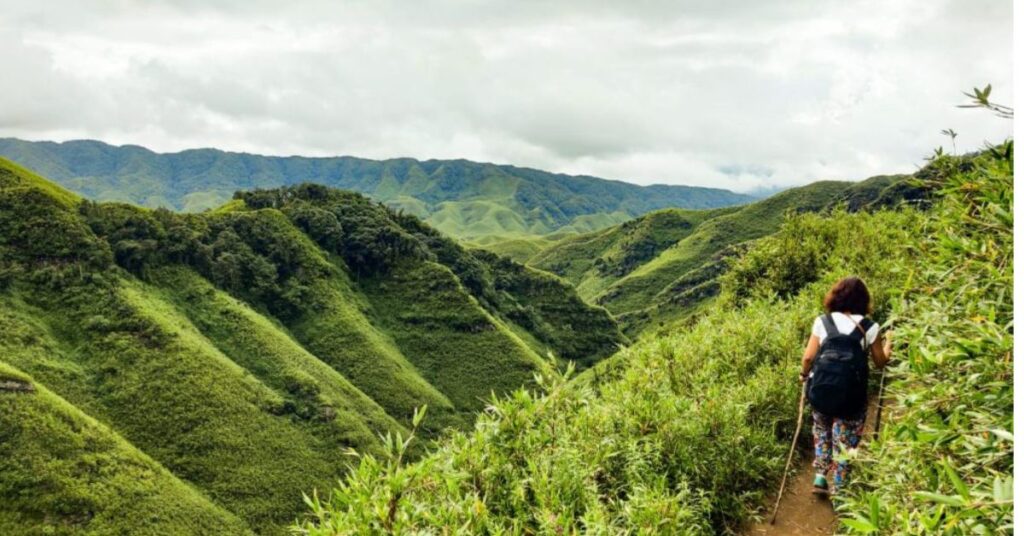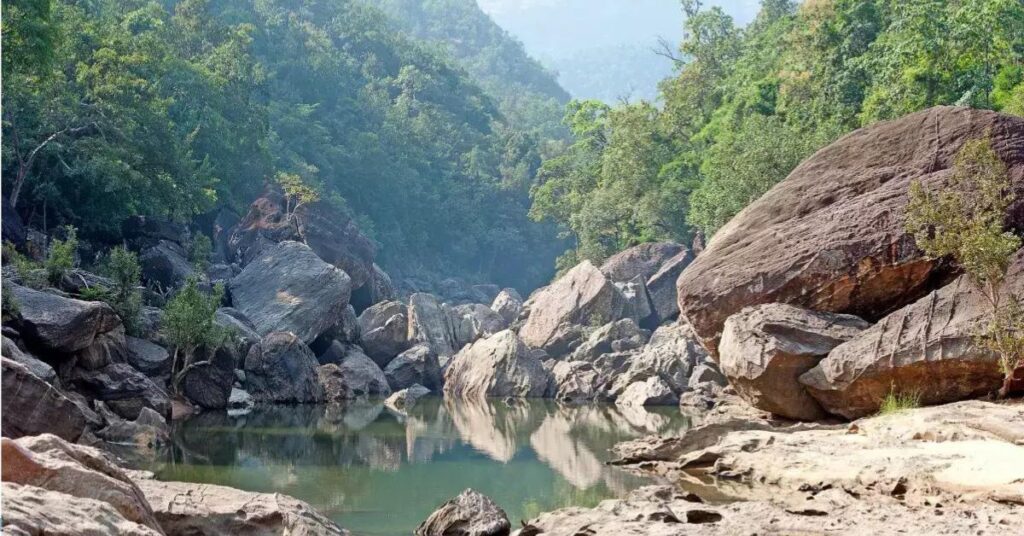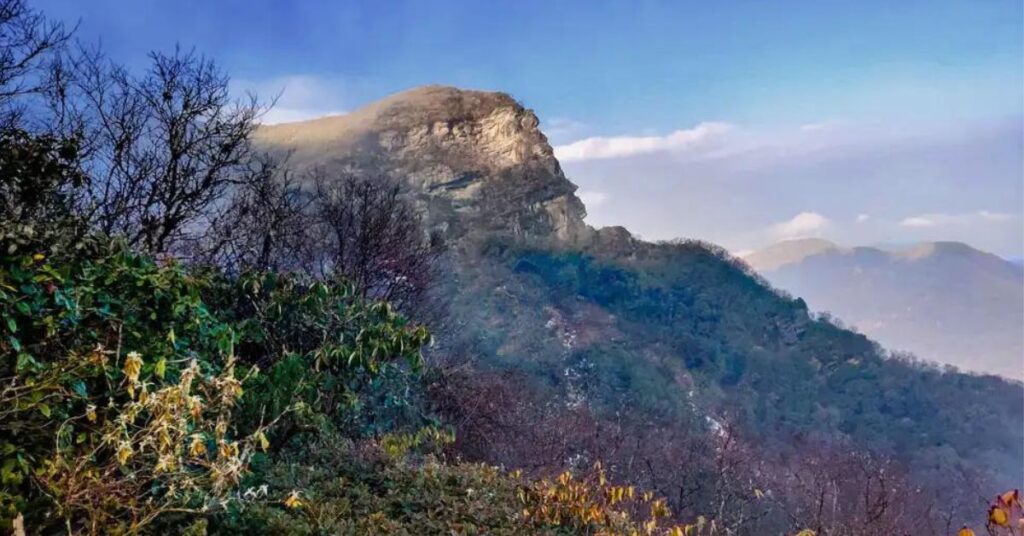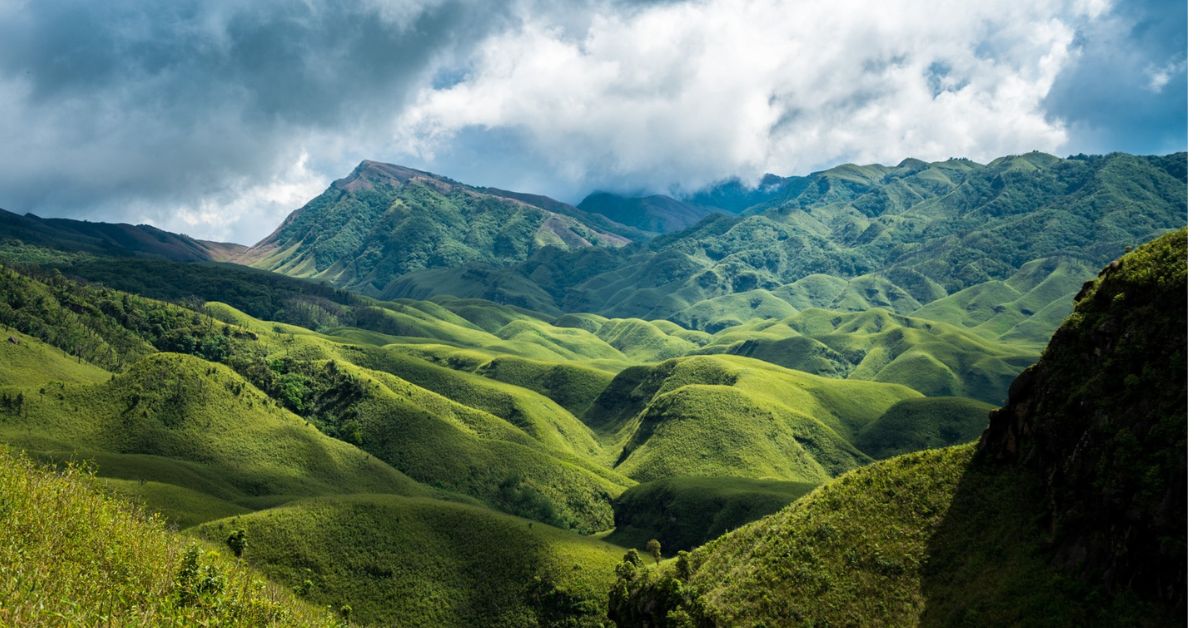Imagine a valley tucked between Nagaland and Manipur. Dzukou Valley isn’t just beautiful, it’s untouched and peaceful. With amazing views, colorful flowers everywhere, and a calming atmosphere, it’s no wonder they call it the “Valley of Flowers of the North-East.” This hidden gem is perfect for nature lovers, hikers, or anyone who wants a break from the city rush.
Sitting high up at 8,000 feet, Dzukou Valley is famous for its rolling green meadows and gentle hills. During the monsoon season, the Dzukou Lily bursts into bloom, adding another layer of magic to the scenery. So, are you ready to discover the beauty and secrets of Dzukou Valley? It’s a true treasure of Nagaland, waiting to be explored.
How to reach:
By Air:
- Fly into Dimapur Airport, the closest airport to Dzukou Valley.
- From Dimapur, it’s a 2-3 hour journey to Kohima by taxi or bus. Taxis are readily available at the airport, while buses run regularly.
By Train:
- Dimapur Railway Station is the nearest major station.
- Trains connect Dimapur to Guwahati, Kolkata, Delhi, and other cities.
- From Dimapur station, take a taxi or bus (around 2-3 hours) to Kohima.
By Road:
- Kohima is the main hub for reaching Dzukou Valley. Here are your options:
- Dimapur: This is the closest major city (74 km away). Regular buses, shared taxis, or private taxis can take you to Kohima in 2-3 hours.
- Imphal: The journey from Imphal is longer (around 145 km, 5-6 hours) but offers scenic views. Buses and shared taxis operate on this route.
- Guwahati: This is the farthest option (370 km, 10-12 hours) but provides a chance to experience the diverse landscapes of Northeast India. Long-distance buses and shared taxis are available.
best time to visit:
Summer (June to September):
- Pros: The valley explodes with life during summer. Lush green meadows and a vibrant display of flowers, including the iconic Dzukou lily, paint a breathtaking picture.
- Cons: Be prepared for monsoon rains! Heavy downpours can make trekking more difficult and the trails slippery.
Early Winter (November to March):
- Pros: Enjoy pleasant, cool weather perfect for trekking. Clear skies offer stunning panoramic views of the entire valley.
- Cons: While not as lush as summer, the landscape takes on a unique winter charm. Don’t expect the same abundance of flowers.
Monsoon (July to September):
- Highlights: Witness the valley at its most verdant, with the Dzukou lily adding its touch of magic.
- Challenges: Heavy monsoon rains can make trekking treacherous.
Winter (December to February):
- Pros: Experience the valley with fewer crowds and clear skies. The cool and pleasant weather makes trekking enjoyable.
- Cons: The vibrant greens and flowers may be less prominent compared to other seasons.
attractions:
Dzukou Valley Trek:

The Dzukou Valley trek is the star attraction for visitors. It’s your chance to dive deep into Nagaland’s unspoiled beauty. You can choose to start your trek from either Viswema or Jakhama village. The trail winds through thick forests, rocky patches, and climbs up some steeper sections. But don’t worry, with every step, the valley’s peaceful beauty unfolds before you.
During the blooming season, these hills come alive with a stunning display of wildflowers. It’s more than just a trek; it’s a journey through some of the most scenic landscapes in Northeast India. Along the way, you’ll find natural caves that are perfect for a quick rest and a chance to explore. The cool, fresh air will leave you feeling invigorated.
Dzukou River:

Flowing like a ribbon through the valley, the Dzukou River is a picture of peace. It’s a welcome break after a challenging trek. The water is crystal clear and calm, making a perfect spot to cool off with a dip or just relax by the riverbank with a picnic.
The river’s untouched beauty reflects the pristine nature of the valley. It’s a haven for various aquatic plants and animals, a hidden world waiting to be discovered. Take some time to explore the scenic spots along the river. Listen to the calming sound of flowing water and soak in the lush greenery. Whether you choose to meditate by the riverside or simply follow its path, the Dzukou River adds a layer of serenity to your Dzukou Valley experience.
Japfu Peak:

Calling all thrill-seekers and nature lovers! Japfu Peak, Nagaland’s second-highest peak, is an adventure waiting to happen. Towering at 10,000 feet (3,048 meters), this peak offers challenging treks that reward you with jaw-dropping views.
The journey to the top takes you through thick rhododendron forests. Imagine hiking through a tunnel of colorful blooms, especially during the blooming season! Keep an eye out for a special resident – the world’s tallest rhododendron tree, reaching a whopping 109 feet!
local experiences:
Unveil Traditions: Meet the local Naga tribes and learn about their fascinating customs, stories passed down for generations (folklore), and unique ways of life. Witness these traditions come alive during local festivals and events, where you’ll be captivated by traditional dances, music, and rituals.
Tantalize Your Taste Buds: Embark on a culinary adventure! Savor the unique flavors of Naga cuisine, known for its use of smoked meats like pork with bamboo shoots, fish cooked in bamboo, and various fermented foods. Be prepared for a burst of flavor and a focus on fresh, organic ingredients.
Treasure Hunt for Souvenirs: Unearth the artistic talents of the Nagas! Shop for handcrafted treasures like handwoven textiles in vibrant colors, beautiful bamboo products, and intricate beadwork. Explore local markets and artisan shops to find the perfect unique souvenir to remember your trip.
Live Like a Local: Experience true Naga hospitality by staying with local families in their traditional homes. Immerse yourself in their daily life and gain a deeper understanding of their culture. Take guided tours through villages like Khonoma to witness the architectural beauty of the Angami tribe and their sustainable farming practices.
Explore the Land: Learn about the ingenious terrace farming techniques used in the region and the importance they place on organic agriculture. Observe the cultivation of local crops and witness traditional farming methods firsthand.
Nature’s Playground: Join experienced local guides on nature walks to discover the diverse flora and fauna of the valley. Keep your eyes peeled for rare and endemic birds while engaging in some bird watching!
travel tips:
- Blooming Beauty (June to September): Witness the valley in its full glory with lush greenery and a vibrant display of flowers, including the iconic Dzukou Lily. Be prepared for potential monsoon rains.
- Clear Skies and Pleasant Treks (November to March): Enjoy clear skies, cool weather, and comfortable conditions for trekking. The landscape might not be as lush, but it has its own winter charm.
- Pack Smart: Bring enough water and snacks to keep you fueled throughout the trek. Comfortable and sturdy shoes are a must. Pack light but don’t forget essentials like a first-aid kit, raincoat, and extra layers of clothing for changing weather conditions.
- Village Homestays: Immerse yourself in local culture by opting for homestays in nearby villages like Viswema or Jakhama.
- Camping Under the Stars: Experience a deeper connection with nature by camping within the valley (permits required).
- Be Prepared: Obtain the necessary permits from the Nagaland Tourism Department or local authorities before your trek. Register at the designated base camp to ensure your safety and compliance with park regulations.
- Local Knowledge: Hiring local guides is highly recommended. They can navigate the trails with ease and share valuable insights about the region’s plants, animals, and cultural significance.
- Helping Hands: Consider hiring porters if you’re carrying heavy backpacks or camping equipment.
- Be Adaptable: The weather can change quickly, especially during the monsoon. Pack warm clothes for early mornings and evenings, even in summer.
- Plan Ahead: Inform someone about your trekking plans and estimated return time. It’s always safer to trek in a group.
- Know Yourself: Be mindful of your physical limitations and acclimatize to the altitude if necessary.
- Dress Modestly: Be mindful of local customs and traditions by dressing modestly.
- Permissions Matter: Always seek permission before taking photographs of people or entering private property.
- Pack It In, Pack It Out: Help preserve the valley’s beauty by carrying out all your trash and disposing of it properly. Stick to designated trails to minimize your impact on the environment.
- Limited Connectivity: Mobile network coverage can be unreliable. Inform loved ones about potentially limited connection. Consider carrying a power bank to keep your devices charged, especially if camping.
- Cash is King: Carry enough cash as ATMs might be scarce in remote areas. Use Indian Rupees (INR) for transactions in villages and smaller towns.
- Hydration is Key: Drink purified or boiled water to avoid waterborne illnesses.
- Eat Safe: Enjoy the local cuisine, but ensure the food is cooked thoroughly and hygienically.
conclusion
Unveiling a hidden gem in Nagaland, Dzukou Valley offers a captivating blend of stunning landscapes, rich biodiversity, and a vibrant cultural heritage. Trek through lush meadows bursting with colorful blooms, or find serenity by the Dzukou River. Explore.com (Xplro.com) unlocks the secrets of this paradise, recommending a visit to Khonoma Village to experience sustainable living and traditional Angami architecture. Savor the unique flavors of Naga cuisine and immerse yourself in local festivals. Plan your adventure with Xplro.com’s valuable tips, ensuring a smooth and respectful visit. From choosing the best season (June-September for blooms, November-March for clear skies) to packing essentials and respecting local customs, Xplro.com guides you to an unforgettable experience in Dzukou Valley.
faqs
What is the optimal time to visit Dzukou Valley?
- The best times to explore Dzukou Valley are from June to September, when the valley is lush and the Dzukou Lily is in bloom. Another great period is from November to March, when the weather is cool and ideal for trekking.
How can I reach Dzukou Valley?
- To get to Dzukou Valley, you should travel to Kohima, the capital of Nagaland. From Kohima, you can take a taxi or bus to Viswema or Jakhama village, which are the common starting points for the trek to Dzukou Valley. The trek itself usually takes about 3 to 4 hours.
Are permits required to visit Dzukou Valley?
- Yes, visitors require an Inner Line Permit (ILP) to enter Nagaland, which can be obtained online or from designated offices. Foreign travelers must also register with the Foreigner Registration Office in Nagaland.
What should I bring for the Dzukou Valley trek?
- For the trek, pack comfortable hiking shoes, a durable backpack, enough water, snacks, a first-aid kit, rain gear, warm clothing, a sleeping bag, and a tent if you plan to camp.
Is trekking in Dzukou Valley safe?
- Generally, trekking in Dzukou Valley is safe. However, it is wise to trek in groups, hire local guides, and inform someone of your plans. Be cautious during the monsoon season due to potentially slippery trails.
Are there places to stay in Dzukou Valley?
- Yes, basic accommodations such as dormitories and camping facilities are available at the valley’s base camp. Alternatively, you can stay in homestays in nearby villages like Viswema and Jakhama for a more comfortable stay.
Can I set up camp in Dzukou Valley?
- Yes, camping is permitted in Dzukou Valley. It’s a popular choice for those who wish to experience the valley’s beauty overnight. Make sure to bring all necessary camping gear and practice Leave No Trace principles.
What types of plants and animals can be seen in Dzukou Valley?
- Dzukou Valley is home to a variety of plant species, including the Dzukou Lily and various wildflowers. The valley also supports diverse wildlife such as birds, butterflies, and small mammals.
Is there mobile network coverage in Dzukou Valley?
- Mobile coverage is limited and often unreliable in Dzukou Valley. It’s advisable to inform family or friends about potential connectivity issues and carry a portable charger for your devices.
How challenging is the trek to Dzukou Valley?
- The trek to Dzukou Valley is considered moderately challenging. It includes a steep initial climb followed by a flatter section. Good physical fitness is recommended, and trekkers should be prepared for changing weather conditions.
Are guided tours available?
- Yes, guided tours are available and are highly recommended for first-time visitors. Local guides can provide valuable information about the valley’s history, flora, and fauna, and help ensure you stay on the right paths.
What cultural norms should I be aware of?
- Respect local customs by dressing modestly, asking permission before taking photographs of people or private property, and observing local traditions. Engage respectfully with the local community and support sustainable tourism practices.




